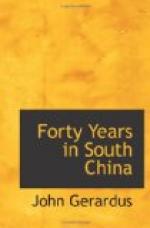Mr. Talmage made an extensive tour on behalf of Missions in China among the Reformed churches in New York, New Jersey, and Pennsylvania.
“Jan. 15, 1850. Was married at twelve M. in First Presbyterian Church at Elizabeth, New Jersey, by Dr. N. Murray, to Miss Abby F. Woodruff. Started immediately with my wife on a trip to Seneca County, New York.”
“March 16, 1850. In the forenoon accompanied by many dear friends we embarked on board the ship Tartar from New York bound for China.”
“July 16th. Arrived safely at Amoy, for which our hearts are full of gratitude to Him who has watched over us on the deep and conducted us safely through every danger.”
Though the entire Reformed Mission at Amoy then consisted of only three members, Mr. Doty and Mr. and Mrs. Talmage, still they believed in colonizing. Mr. Talmage secured a Chinese house and shop a mile or more away from the original headquarters and this became the missionary’s home and preaching place. It was on the north side of the city in a densely populated neighborhood known as “Tek-chhiu-Kha,” or “At the Foot of the Bamboos.”
It fronted one of the main thoroughfares of the city. It was near the water’s edge at the mooring-place of junks from the many-peopled districts of Tong-an and Lam-an. The house and shop were renovated and capped with another story. Here Mr. Talmage prayed and studied and preached and planned for nearly twenty years. On this spot to-day stands a flourishing Chinese church.
In a letter to Drs. Anderson and De Witt, dated Dec. 17, 1850, Mr. Talmage thus describes their new home:
“Our house is pleasantly situated, having a good view of the inner part of the harbor, and of several small islands in the harbor. We also have a pleasant view of the mainland beyond the harbor. From our house we can count a number of villages on the mainland, beautifully situated among large banyans. We hope the situation will prove a healthy one. I like the situation most of all because I think it well adapted to our work. We are near the northern extreme of the city along the water’s edge, while the other missionaries are near the southern extreme. Thus on entering the harbor from Quemoy and other islands, near the mouth of the harbor or from the cities and villages on the seacoast, the first foreign residence at Amoy, which meets the eye, is the residence of missionaries. On coming to Amoy from the cities and villages which are inland, again the first foreign residence which meets the eye is the residence of missionaries. We are in a part of the city where the Gospel has not yet been preached.”
In the same letter he refers to the Opium habit—and to the initiatory steps toward the formation of a Romanized alphabet for the Amoy Vernacular. The Chinese character is learned with great difficulty. It requires years of close application. In Southern Fukien not more than one man in a hundred can read intelligently. It is doubtful whether one woman in ten thousand can.




